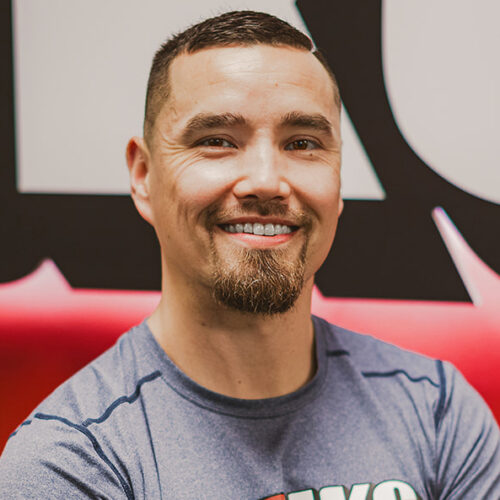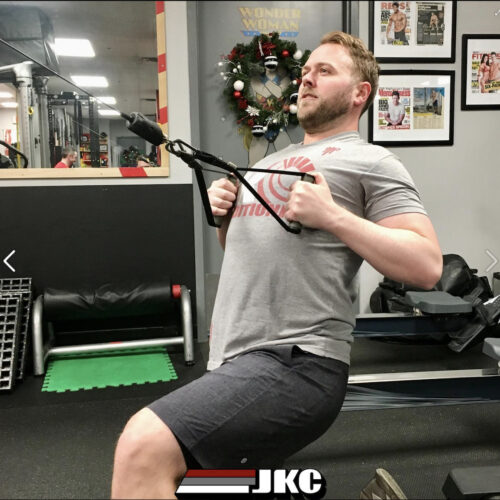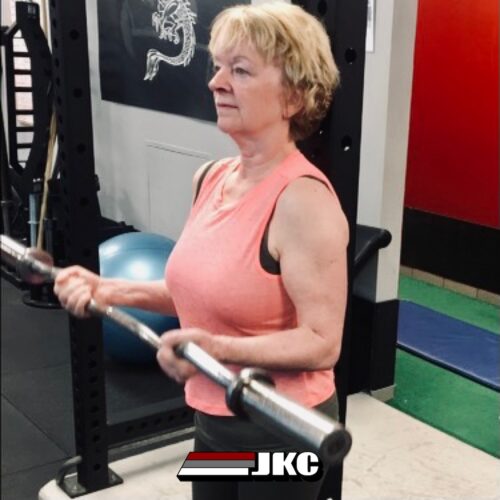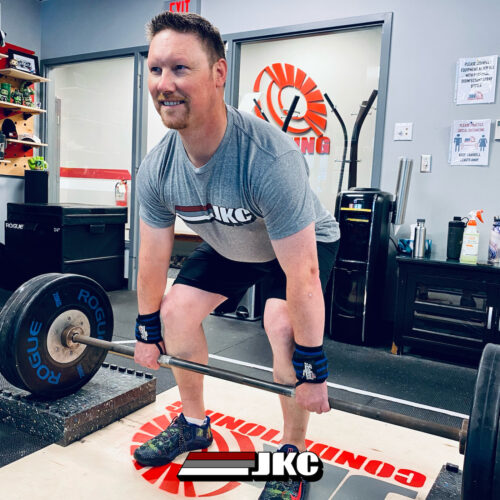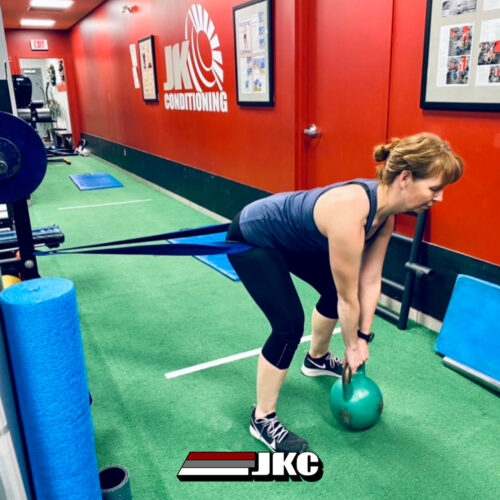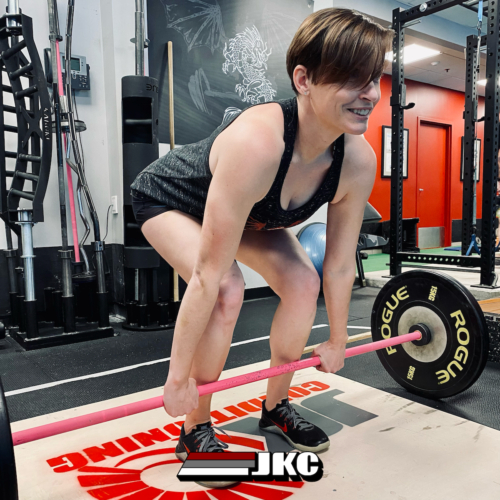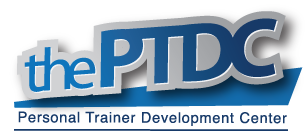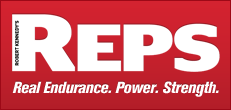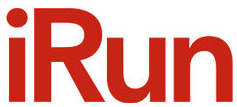 Well, when I first heard word that Tony Gentilcore was going to let me interview him for my blog, I thought it was going to be all about bacon. I was half right 😉
Well, when I first heard word that Tony Gentilcore was going to let me interview him for my blog, I thought it was going to be all about bacon. I was half right 😉
Before we get started, Tony sent me this video of him wearing a JKConditioning Dragon Tee while pulling an easy 500-lbs. If you want to be as cool as Tony, you can grab your Dragon Tees HERE.
On to the goods…
JK: Thanks for taking the time out of your busy schedule to answer these questions Tony. For those that don’t know you (shame on you!), can you tell us why you’re cooler than a polar bear’s toe nails?
TG: It’s my pleasure man. I know you and I have been meaning to do this for a while now, so it’s nice that we finally have the time to squeeze it in, even though you did “shaft” me when I came to Vancouver to visit a few months ago. Yeah, yeah…….anniversary smashmersary. I’m sure your wife wouldn’t have minded if you asked her to take a rain check on the romantic weekend you had planned in lieu of hanging out with me so we could get our deadlift on.
Okay, yeah, that probably wouldn’t have been a wise choice. At least we were finally able to meet up in Toronto for the PTDC Hybrid Training Seminar this past June. Not to sound like a creepy internet stalker or anything, but I was really glad to finally meet you in person since you’re now blowing up EVERYWHERE. Seriously dude, I can’t open up a magazine without coming across something you’ve written. I think it’s awesome, and it’s well deserved!
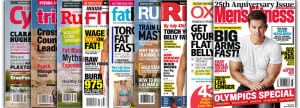
Hey, wait a second, this is supposed to be about ME dammit!!!
Okay, to save people some time, I’ll give everyone the Cliff Notes Version.
1. I grew up in a VERY small town in central NY in the Finger Lakes region. And when I say small, I mean my high school graduating class was 55 people small. My hometown doesn’t even have ONE traffic light small. We didn’t even get the internet until 2010 small.
Okay, that last one was an exaggeration. But I’m not kidding when I say I’m from the middle of nowhere, USA.
2. In 2005, after working as a personal trainer in corporate fitness and several commercial gyms for three years, Eric Cressey convinced me to move out to New England where he and I worked together at a privately owned commercial gym in Connecticut.
3. Within that time, I got my CPT and CSCS through the NSCA and girls eventually wanted to hang out with me.
4. After a year in CT, we both moved to Boston, and I became a RedSox fan. I know, they suck this year. Don’t get me started.
5. In the summer of 2007 we opened up Cressey Performance in Hudson, MA, about 25 miles west of Boston. We recently celebrated our fifth year of operation, and we’re about five weeks away from moving into a ginormous 15,000+ square foot facility that’s going to be epic in its epicness.
6. Not to blow sunshine up our own butts (okay, maybe a little bit), I’d argue that we’re the premiere baseball training facility on the east coast, if not the entire United States. And we’re NOT just a place where some of the best baseball players in the country come train: we also have clients from every other sport imaginable, as well as a fair amount of “Average Joe’s” who tend to take their health and well-being a little more seriously.
7. On a more personal level, I’ve been lucky enough to make a small name for myself outside the umbrella that is Cressey Performance, and have managed to build a fairly popular health and fitness blog (you should check it out HERE), and am regularly writing for places like T-Nation.com, Livestrong.com, and Men’s Health Magazine, among others.
8. I also own a cat, and have watched the Lord of the Rings trilogy like ten times, which automatically makes me cool. So there’s that.
JK: Since you have the word CORE in your last name, you must know a thing or two about the core assessments and core training. I see the words core strength, core endurance, and weak core thrown around the interweb much too often. What’s your favourite assessment of the core and what’s your goal for improving core function?
TG: A quick aside, if I ever have aspirations of opening up my own facility someday (which, right now I don’t), I already have the perfect name for it. Core!
Now, tell me: does that not sound like the most badass name for a gym, like ever?
Getting back on task, though, you’re completely correct that the word “core” is synonymous with, well, no one knows what the hell it means. For some, the word “core” equates to what they see on the cover of Men’s Health or any other number of fitness mags each and every month. Everyone wants a six pack, and while it is commendable if you’re one of the lucky few who isn’t skeered to take his shirt off on the beach, that doesn’t necessarily mean you have a strong and “functional” core. All it really means is that you’re not fat. That’s cool and all, but it doesn’t really give you the whole picture.
For others, and I’ll throw myself in this category, it’s a bit more complicated. The core, for all intents and purposes, includes everything that’s below the neck. Everything. In a sense, the core is the entire body, working as a unit to generate and transfer force as efficiently as possible with as little “leaks” as possible.
There are plenty of guys out there with impressive six packs who, while they look like Tarzan, perform like Jane (no offense to any women reading. Just trying to make a point). I mean, what good is it to have an impressive six pack if you can’t punch yourself out of a wet paper bag, or worse, as to “dysfunctional” that you suffer from chronic back pain?
I like to keep things simple, and as far as “assessing” core performance look no further than the push-up! Simply stated: can someone perform a push-up correctly? Sadly, many do not. Do they have ample pelvic-lumbo-hip control (anteriorly AND posteriorly) to resist the pull of gravity and not compensate in any way?
Watch most trainees perform a push-up, and you’re bound to see a litany of compensation patterns ranging from the head jolting forward, elbows flaring out, to the most obvious one(s) of all: hyperextension of the lumbar spine (due to poor pelvic strength and control) and an excessive rounded upper back (due to the rectus abdominus dominating the external obliques).

For me, as a strength coach, and as someone who’s always looking to improve people’s performance, I’m going to place a premium on core STABILITY!!!!
This doesn’t mean I’m going to plank people to death, however. While I’d be remiss not to mention how important it is to build spinal endurance (especially with regards to the mountain of research and info that guys like Dr. Stuart McGill and Dr. Craig Liebenson have produced), spending an inordinate amount of time making clients perform prone and side planks is about as exciting as watching paint dry.
To that end I prefer to have people incorporate exercises like Pallof presses, various chops and lifts, making sure that they’re engaging their glutes and incorporating the entire kinetic chain. Taking it step further, I LOVE farmer carries – especially offset loads where a trainee carries one dumbbell (or kettlebell) at a time.
Here, there’s really no “coaching” required. The body kinda automatically knows what the deal is, and it’s uncanny how quickly someone realizes, “oh, so those are my obliques are!”
Really, if we’re going to be honest with ourselves, improving “core function” is about helping people move better and taking into account the joint-by-joint approach popularized by Gray Cook and Mike Boyle. Some joints need to be trained with MOBILITY in mind (t-spine, hips, etc), and some joints need to be trained with STABILITY in mind (knees, lumbar spine, etc).
It’s a little deeper than that, and something I don’t want to get too off-track with, but needless to say, improving one’s movement quality – and getting the core to actually do it’s job – has profound effects not only on one’s performance, but aesthetics come into play, too.
JK: From stalking you on Facebook and your blog, I know there is nothing more important in your life than deadlifting and bacon (and your new cat). There are a kagillion articles on deadlifting out there. In your expert opinion, what’s the best method/program deadlift two ton Tessie?
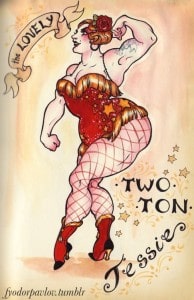
TG: That is true, I do love bacon. And, it’s funny: if you would have told five years ago that I’d eventually own a cat, I probably would have 1) laughed in your face, and 2) make some kind of joke that I was more likely to listen to John Mayer while eating tofu in my Prius on my way to a yoga class.
But it’s true, my name is Tony Gentilcore, and I own a cat.
So bring this to a more manly discussion, lets talk about deadlifts! What’s the best method/program to pull over two ton Tessie?
1. For starters, I really wish people would just get off the freakin internet, go to the gym, and actually lift some heavy shit. There are countless “internet warriors” out there that all they do is talk and talk and talk, and speculate, and argue, and brag about how many posts they have on any given forum, and any number of other things equally as dumb, and yet forget one key component: you need to actually lift some damn weight!
Stop talking, get your ass to the gym, place some weight on the bar, get angry, and then lift it……sometimes repeatedly.
2. Speaking more colloquially, it really comes down to one simple concept: PROGRESSIVE OVERLOAD.
Here’s a personal reference. I didn’t start deadlifting until 2004. I shit you not, you can probably find posts on T-Nation where I’m asking people “what are these deadlifts you speak of?”
Like a lot of people I started out lifting weight at a young age and followed more of a body part per day split. Chest day, back day, blah blah blah. Trust me, a little piece of my soul dies just thinking about it. I can’t even begin to tell you how much I cringe looking back at how I trained as a high school and even collegiate athlete. If I ever had the chance to take a time machine back to 1994, I’d totally go back and Sparta kick myself in the face.
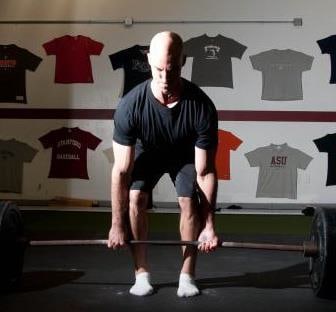
While I laugh and make fun of it, you know what? I always, and I mean ALWAYS had it in my mind to consistently try to lift heavier loads – whether it was adding a rep here and there, or incrementally increasing the load. That just made sense, ya know? I didn’t need anyone to tell me otherwise.
Anyways, so I started reading a few things here and there and slowly but surely started to understand that, for lack of a better term, I was training like a moron. I started incorporating deadlifts into my weekly training. I nixed the leg press, and started learning to squat to depth (a very humbling experience I might add).
One day I decided to test my 1RM deadlift. Mind you, I had NEVER tested my 1RM before. On day one I hit a 420 lb lift. Not too shabby. The kicker? I didn’t even train for it. All I did was focus on progressive overload. I wasn’t on internet forums arguing about foot placement or set/rep schemes or whether or not Han shot before Greedo (token Star Wars reference there). I was in the gym. Training.
Shut up, and train. It’s that simple. If more people did that…….they’d see marked improvements in their lifts.
I know that that wasn’t the “x’s and o’s” answer you were looking for, but I just feel that we’re living in an age where people are so inundated with information, that they’ve become paralyzed. It’s literally gotten to the point where people over-think things so much – should I do 5×5 or 4×4; So and so said I should wait 47 seconds between sets in order to elicit optimal growth hormone elevation; For max strength, this article said to use a 212 tempo, but my best friend’s brother’s second cousin’s Little League coach said to use a 311 tempo – that they forget one crucial thing. Fucking lift!!!!!!
JK: Tell people (without writing a new textbook) why people need to earn the right to overhead press.
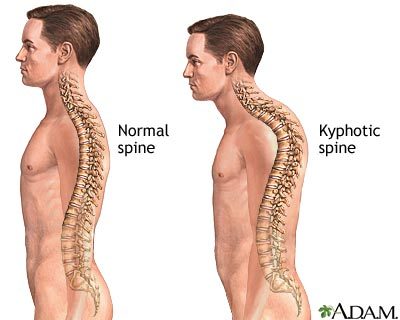 TG: Not to sound like a broken record, but we have the mobility of a crow bar. People DO NOT move very well nowadays. Back in the day – and I know I’m aging myself here – the internet didn’t exist. Well, it did, but there weren’t nearly as many free porn sites.
TG: Not to sound like a broken record, but we have the mobility of a crow bar. People DO NOT move very well nowadays. Back in the day – and I know I’m aging myself here – the internet didn’t exist. Well, it did, but there weren’t nearly as many free porn sites.
When I was an adolescent and teenager, I was outside, literally, all day. I’d be riding my bike, playing wiffle ball, kick-ball, basketball, soccer, I’d go swimming, go on small hikes with my dog, you name it, I did it.
This isn’t to say that I didn’t crush R.B.I Baseball and Mike Tyson’s Punch-Out on my Nintendo from time to time, but looking back, I spent a vast majority of my childhood outside playing, being a kid.
Today it’s a different story altogether. While kids are still active (I guess), they’re not nearly as active as when I was their age. Today, you have kids who are more likely to be champion texters than champions in an actual sport.
Moreover, we have adults who spend upwards of 10-15 hours – per day – starring at a computer screen and hating life.
We just don’t move well. Subsequently, we have people who have any number of postural imbalances, dysfunctions, injuries, and movement impairments.
We had a guy come to the facility not too long who couldn’t even raise his arms above his head without wincing in pain ask whether or not he should be including any snatches in his program.
Uh, no! You can’t lift your arms over your head!
I have NOTHING against overhead pressing. When the time is right, and it fits the needs (and capabilities) of the individual, I include it into many of my programs, as they’re an awesome movement to build size, strength, and overall badassery. But people need to earn the right to do it. Far too many people are jacked up nowadays that the cost-benefit of overhead pressing has to be part of the conversation. If they can do it, great! Have at it. But those people are few and far between, unfortunately.
JK: Wow. Mind = blown. Thanks so much for taking the time to do this interview Tony. We now all know why you’re cooler than a polar bear’s toe nails. How can people find you?

TG: They can reach me at my blog at www.tonygentilcore.com.
Thanks again Tony and thanks for reading.
-JK
